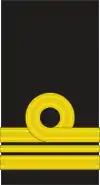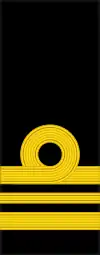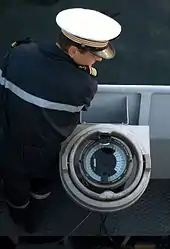Lieutenant commander
Lieutenant commander (also hyphenated lieutenant-commander and abbreviated Lt Cdr,[1] LtCdr.[2] or LCDR[3][4]) is a commissioned officer rank in many navies. The rank is superior to a lieutenant and subordinate to a commander. The corresponding rank in most armies (armed services) and air forces is major, and in the Royal Air Force and other Commonwealth air forces is squadron leader.

| Naval officer ranks |
|---|
| Flag officers |
| Senior officers |
| Junior officers |
The NATO rank code is mostly OF-3.[5]
A lieutenant commander is a senior department officer or the executive officer (second-in-command) on many warships and smaller shore installation, or the commanding officer of a smaller ship/installation.[6] They are also senior department officers in naval aviation squadrons.
Etymology
Most Commonwealth and other navies address lieutenant commanders by their full rank or the positions they occupy ("captain" if in command of a vessel). The United States Navy, however, addresses officers by their full rank or the higher grade of the rank. For example, oral communications in formal and informal situations, a lieutenant (junior grade) is abbreviated as "lieutenant," and a lieutenant commander is abbreviated as "commander."[7]
Origins
Lieutenants were commonly put in command of smaller vessels not warranting a commander or captain. Such a lieutenant was called a "lieutenant commanding" or "lieutenant commandant" in the United States Navy, and a "lieutenant in command," "lieutenant and commander," or "senior lieutenant" in the Royal Navy. The USN settled on "lieutenant commander" in 1862 and made it a distinct rank. The RN followed suit in March 1914.[8]
United Kingdom
Royal Navy

The insignia worn by a Royal Navy lieutenant commander is two medium gold braid stripes with one thin gold stripe running in between, placed upon a navy blue/black background. The top stripe has the ubiquitous loop used in all RN officer rank insignia, except for the rank of Midshipman. The RAF follows this pattern with its equivalent rank of squadron leader.
Having fewer officer ranks than the army, the RN previously split some of its ranks by seniority (time in rank) to provide equivalence: hence a lieutenant with fewer than eight years seniority wore two stripes, and ranked with an army captain; a lieutenant of eight years or more wore two stripes with a thinner one in between, and ranked with a major. This distinction was ostensibly abolished when the rank of lieutenant commander was introduced, although promotion to the latter rank was automatic following accumulation of eight years’ seniority as a lieutenant. Automatic promotion was stopped at the start of the 21st Century and promotion is now only awarded on merit.
Royal Observer Corps
Throughout much of its existence, the British Royal Observer Corps (ROC) maintained a rank of observer lieutenant commander. The ROC wore a Royal Air Force uniform and their rank insignia appeared similar to that of an RAF squadron leader except that the stripes were shown entirely in black. Prior to the renaming, the rank had been known as observer lieutenant (first class).
Canada

In the Royal Canadian Navy, the rank is the naval rank equal to major in the army or air force and is the first senior officer rank. Lieutenant commanders are senior to lieutenants (N) and to army and air force captains, and are junior to commanders and lieutenant colonels.[5]
United States
There are two insignia used by USN and USCG lieutenant commanders. On service khakis and all working uniforms, lieutenant commanders wear a gold oak leaf collar device, similar to the ones worn by majors in the USAF and Army, and identical to that worn by majors in the Marine Corps. In all dress uniforms, they wear sleeve braid or shoulder boards bearing a single gold quarter-inch stripe between two gold half-inch strips (nominal size). Above or inboard of the stripes, they wear their speciality insignia (i.e., a star for officers of the line, single oak leaf for medical with silver acord for Medical Corps, crossed oak leaves for Civil Engineer Corps, United States shield for Coast Guard, etc.) The U.S. Navy designates the rank as O-4.[9]
Pakistan

This rank is also used in the Pakistan Navy.[10]
Philippines
 Philippine Navy Lieutenant commander's sleeve insignia
Philippine Navy Lieutenant commander's sleeve insignia Philippine Navy Lieutenant commander's shoulder insignia
Philippine Navy Lieutenant commander's shoulder insignia
The Lieutenant Commander rank is also used by both the Philippine Navy and Philippine Coast Guard.
Ireland

The rank of lieutenant commander is also used in the Irish Naval Service, having a similar implication to the RN rank. The majority of vessel commanders in the Irish Naval Service hold the rank of lieutenant commander, with a commander being a senior, shore-based position.
Other countries

The rank corresponding to lieutenant commander in the German Navy, Italian Navy, Argentine Navy, Brazilian Navy, French Navy, Spanish Navy and most other French and Spanish-speaking countries is corvette captain. The corresponding rank in the Estonian and Portuguese navies is captain lieutenant. In the Russian Navy lieutenant commander is "captain of the third rank" (капитан 3-го ранга), and in the Polish Navy it is komandor podporucznik.[5] In the Finnish Navy the equivalent rank is komentajakapteeni, "commander captain"; the rank insignia of komentajakapteeni is three stripes of equal width. The insignia of kapteeniluutnantti, the rank immediately below the former, is one thin stripe between two wider ones, which could cause some confusion among the naval personnel of other nations. In Swedish the rank is called Örlogskapten, in Danish Orlogskaptajn and in Norwegian Orlogskaptein.
References
| Wikimedia Commons has media related to Lieutenant Commanders. |
- "Triservice Officers Pay and Grade" (PDF). UK Government. Archived (PDF) from the original on 2016-03-04. Retrieved 2013-04-25.
- "A Dane giving the orders". Admiral Danish Fleet. Archived from the original on 2013-10-22. Retrieved 2013-04-25.
- "US Navy Ranks". United States Navy. Archived from the original on 2013-05-02. Retrieved 2013-04-25.
- "Uniform Ranks". Royal Australian Navy. Archived from the original on 2015-01-24. Retrieved 2013-04-25.
- "NATO Standard Agreement (STANAG) 2116: NATO Codes for Grades of Military Personnel". NATO standardization agreement (5 ed.). NATO Standardization Agency (published 25 February 2010). 13 March 1996. Archived from the original on 1 September 2011. Retrieved 13 July 2017.
- "United States Navy - O-4 Lieutenant Commander". FederalPay.org. Archived from the original on 2018-05-08. Retrieved 2017-05-22.
- "MILPERSMAN 5000-010" (PDF). U.S. Navy. 22 Aug 2002. Archived (PDF) from the original on 6 October 2016. Retrieved 28 June 2016.
- "Lieutenant Commander mokong Ibana". Archived from the original on 27 May 2009. Retrieved 6 October 2009.
- "United States Department of Defense". www.defenselink.mil. Archived from the original on 30 December 2004. Retrieved 8 May 2018.
- "Life in Pakistan Navy:Ranks". Pakistan Navy Official Website. 2012. Archived from the original on 24 January 2013. Retrieved 13 July 2017.